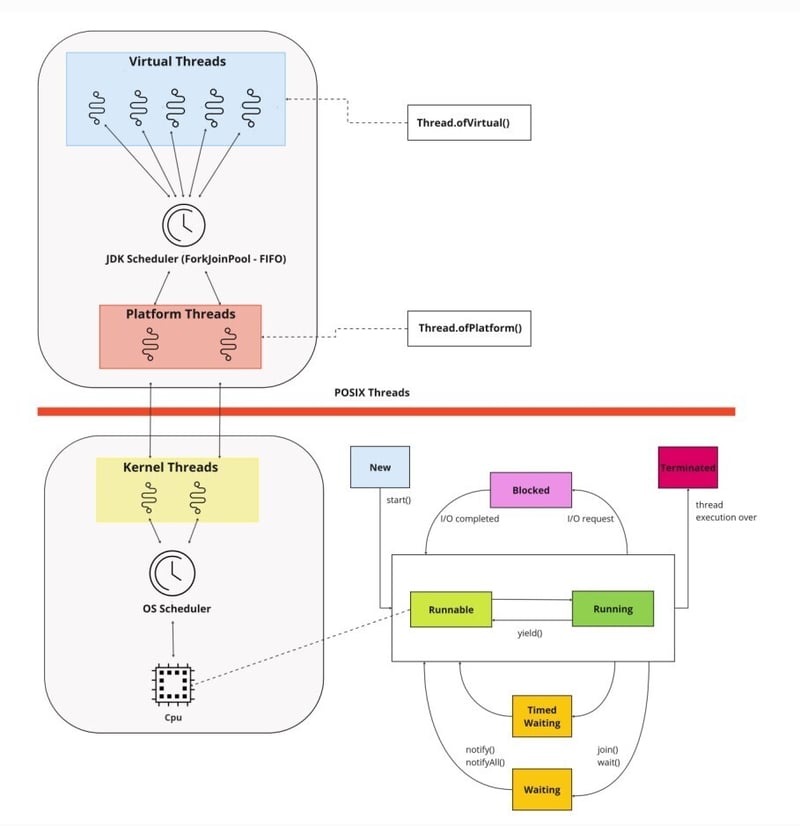Rumah >Java >javaTutorial >Meneroka Penyematan dalam Mekanisme Benang Maya JVM
Meneroka Penyematan dalam Mekanisme Benang Maya JVM
- PHPzasal
- 2024-08-31 16:37:031153semak imbas
Java's virtual threads offer a lightweight alternative to traditional OS threads, enabling efficient concurrency management. But understanding their behavior is crucial for optimal performance. This blog post dives into pinning, a scenario that can impact virtual thread execution, and explores techniques to monitor and address it.
Virtual Threads: A Lightweight Concurrency Approach
Java's virtual threads are managed entities that run on top of the underlying operating system threads (carrier threads). They provide a more efficient way to handle concurrency compared to creating numerous OS threads, as they incur lower overhead. The JVM maps virtual threads to carrier threads dynamically, allowing for better resource utilization.
Managed by the JVM: Unlike OS threads that are directly managed by the operating system, virtual threads are created and scheduled by the Java Virtual Machine (JVM). This allows for finer-grained control and optimization within the JVM environment.
Reduced Overhead: Creating and managing virtual threads incurs significantly lower overhead compared to OS threads. This is because the JVM can manage a larger pool of virtual threads efficiently, utilizing a smaller number of underlying OS threads.
Compatibility with Existing Code: Virtual threads are designed to be seamlessly integrated with existing Java code. They can be used alongside traditional OS threads and work within the familiar constructs like Executor and ExecutorService for managing concurrent.
The figure below shows the relationship between virtual threads and platform threads:

Pinning: When a Virtual Thread Gets Stuck
Pinning occurs when a virtual thread becomes tied to its carrier thread. This essentially means the virtual thread cannot be preempted (switched to another carrier thread) while it's in a pinned state. Here are common scenarios that trigger pinning:
- Synchronized Blocks and Methods: Executing code within a synchronized block or method leads to pinning. This ensures exclusive access to shared resources, preventing data corruption issues.
Code Example:
import java.util.concurrent.ExecutorService;
import java.util.concurrent.Executors;
public class Main {
public static void main(String[] args) throws InterruptedException {
final Counter counter = new Counter();
Runnable task = () -> {
for (int i = 0; i be3c6ba0a699aca98d67df8bee3b84fd {
for (int i = 0; i 4596771306681ecdae85c561b8883cd6 {
for (int i = 0; i < 100; i++) {
counter.increment();
}
};
Thread thread1 = Thread.ofVirtual().start(task);
Thread thread2 = Thread.ofVirtual().start(task);
try {
thread1.join();
thread2.join();
} catch (InterruptedException e) {
throw new RuntimeException(e);
}
System.out.println("Final counter value: " + counter.getCount());
}
}
class Counter {
private int count = 0;
private final ReentrantLock lock = new ReentrantLock();
public void increment() {
lock.lock();
try {
Thread.sleep(100); // This simulates a blocking call
count++;
} catch (InterruptedException e) {
e.printStackTrace();
} finally {
lock.unlock();
}
}
public int getCount() {
return count;
}
}
In the updated example, we use a ReentrantLock instead of a synchronized block. The thread can acquire the lock and release it immediately after it completes its operation, potentially reducing the duration of pinning compared to a synchronized block which might hold the lock for a longer period.
Kesimpulannya
Benang maya Java berdiri sebagai bukti evolusi dan keupayaan bahasa. Mereka menawarkan alternatif segar dan ringan kepada rangkaian OS tradisional, menyediakan jambatan kepada pengurusan konkurensi yang cekap. Mengambil masa untuk menggali secara mendalam dan memahami konsep utama seperti penyematan benang boleh melengkapkan pembangun dengan pengetahuan untuk memanfaatkan potensi penuh benang ringan ini. Pengetahuan ini bukan sahaja menyediakan pembangun untuk memanfaatkan ciri yang akan datang tetapi juga memperkasakan mereka untuk menyelesaikan isu kawalan serentak yang kompleks dengan lebih berkesan dalam projek semasa mereka.
Atas ialah kandungan terperinci Meneroka Penyematan dalam Mekanisme Benang Maya JVM. Untuk maklumat lanjut, sila ikut artikel berkaitan lain di laman web China PHP!

